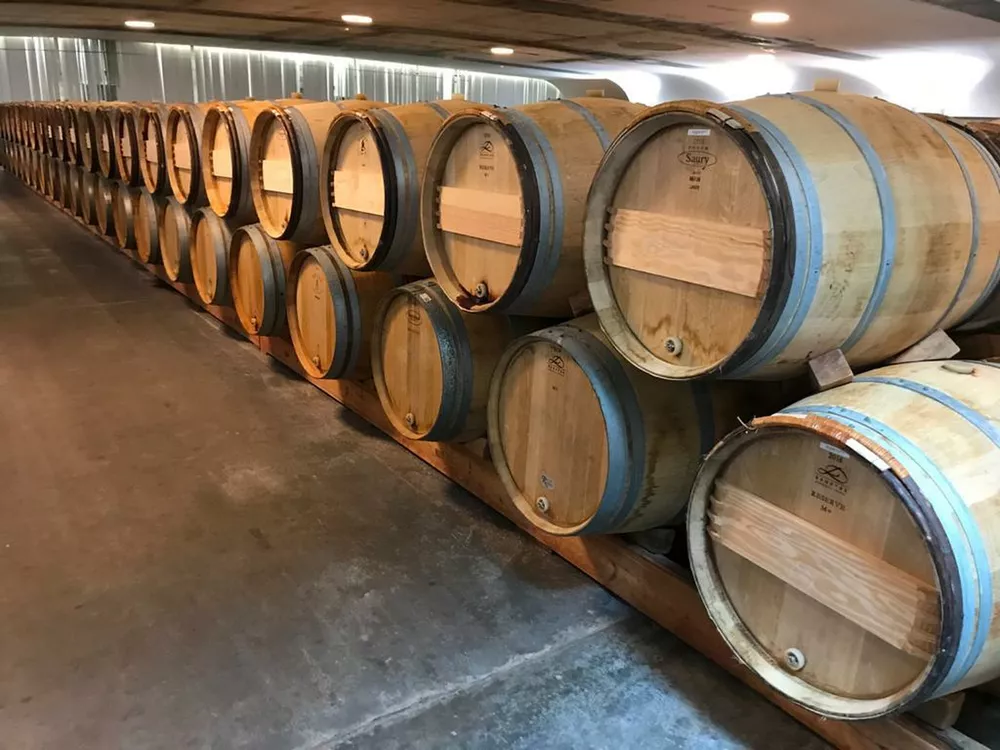From vine to pallet to palate
In his 2005 book, ‘A Wine Miscellany’, author, Graham Harding argues: “wine is not just ‘the fermented juice of grapes’.”
The journey from vine to glass is a matter of science and circumstance. There are a wide number of species of vines which bears a variety of grapes, known as varietals. For instance, the Chardonnay grape is green and produces white or ‘blanc’, Chardonnay wine. Each varietal, affected by soil type, climate, wind, farming practices and other factors, produces various characteristics. In South Africa, it is not legal to add flavourants. As such, when Chardonnay is said to exhibit vanilla, for instance, certain winemaking processes might exhibit that character. For example, aging, or maturing wine in wood can produce certain tastes and smells.
But how does a grape on a vine become a Chardonnay wine, and how does that grape go from a vine to your wine glass?

Step One: Harvest Picking
Olive Hamilton Russell’s celebrated cookbook, ‘A Year on a Cape Wine Estate Entertaining at Hamilton Russell Vineyards’, describes winemaking through all four seasons.
In South Africa, grape harvesting generally begins in February, depending on the progress of the grapes and the process of harvesting can last over a month, depending on the winemaker and viticulturist’s decision. Picking grapes is dual decision, made by science and taste. Grapes are picked according to their sweetness, flavour and acidity.
Olive writes, “February is the month of harvest: Nature’s finale and what all the year’s vineyard work has built towards.”
Grape picking is generally done by hand in South Africa. This helps the picker to harvest the best quality grapes, machines also tend to decimate the vine. Grapes can, likewise be hand-sorted or sorted mechanically. Grapes are tipped onto the sorting table, grapes which are under-ripe or over-ripe are discarded.
Picking begins early in the morning, February’s heat is felt as the day draws on. Grapes are generally picked by the bunch, tossed into baskets, which are sent to the cellar.

Step Two: Cellar Crush
Winemaker, Chris Albrecht describes the crush-pad as ‘a hive of activity’ during harvest.
The crush pad, an area in front of the cellar, is like a beehive. Grapes arrive from various vineyards where they await their fate. Grapes are crushed, de-stemmed, settled, filled into barrels or steel tanks, pumped over, punched down and monitored carefully in their journey from vineyard to cellar in this busy hive.
While picking and sorting is preferably done by hand, enthusiastic wineland tourists have participated in grape pedicures. Traditionally, grapes have been crushed by foot-stomping, however, this process is generally performed mechanically.

As homebrewers have known since time immemorial, time is of the essence when dealing with fresh fruit.
Generally, when white wine is crushed, seeds, skins and other solids are separated, in order to prevent tannins and colour from affecting the wine. For ‘orange’ or skin contact wine, the winemaker discerns how long they prefer to allow skins to ferment with the free-run juice. This affects the colour as well as the chemistry.
For red wine, tannins, flavour and colour are derived from the seeds, skin and other solids, as such, after crushing, the juice is fermented with the solids.
The process involves regular monitoring, measuring of acid, ester, sugar and other levels and consistent tasting. Like a science lab, few places are cleaner than a cellar during harvest. Even foot pressers know to scrub between their toes as any interference can affect the taste of the resultant wine.
Step 3: Fermentation
As ‘the great home-brew of 2020’ demonstrated, the process of transforming sugar from fruit into alcohol is known as fermentation.
Fermentation happens rapidly, within 6-12 hours, alcohol can begin to form. As such, the fermentation process often occurs parallel to the crushing process.
Often, winemakers add yeast to aid the fermentation process. Generally, for commercial winemaking, the correct culture can facilitate taste, flavour and guide consistency. However, yeast is a bi-product of the fermentation process, as such, winemakers often use wild yeast, produced by the grape juice itself, to ferment the wine.
The entire fermentation process depends on what the winemaker is trying to achieve. For instance, the second fermentation, in the bottle, is known as the traditional method, for making sparkling wine.

Step 4: Filtration or Fining
During the process of wine tasting, a wine-lover often holds their glass up to the light or looks at their glass over a sheet of white paper. Generally, this is done to ascertain colour and clarity – like a diamond.
For wine, clarity is achieved by removing tannins, yeast and other material from the wine.
Filters are used to gather large particles, while fining involves adding substances to the wine to achieve clarity. For instance, when clay is added to wine as a fining agent, particles stick to the clay which settles at the bottom of a tank.
Once particles, like proteins or yeast have been removed and the wine has been clarified, wine is aged in barrels or bottles.
Step 5: Bottle or Barrel
If that Chardonnay grape has successfully survived picking, crushing, fermentation and clarification, it is rocking and rolling towards your wine glass.
The winemaker’s sagacity and the consumer’s tastes determine maturation. The wine can either be bottled after clarification, or is transferred to vessels for storage and maturation.
For instance, wood can transfer flavours, colour and characteristics on the wine. In wood, oxygen exposure is increased, which means that tannins are reduced. Some wood can give wine a spicy character, or even make the wine smell different. The grain of the wood also affects how much wine evaporates and is ‘shared with the angels’.
While the vineyards are dormant in winter, the cellar remains a center for tasting and testing. In the vineyards, vines are pruned throughout winter, in preparation for the next year or wine ‘vintage’.
The vineyard begins to ‘make wine’ as the bud breaks, vines bear fruit and the weather becomes warmer. In the cellar, decisions are made about bottling, storage and preparation for the upcoming harvest as the grapes in the vineyard begin to feel the heat.

Step 6: Enjoy
Even after picking, crushing, fermenting, fining and storage – the essential component to the winemaking process is the person who opens the bottle, pours it and appreciates the journey from grape to glass.











